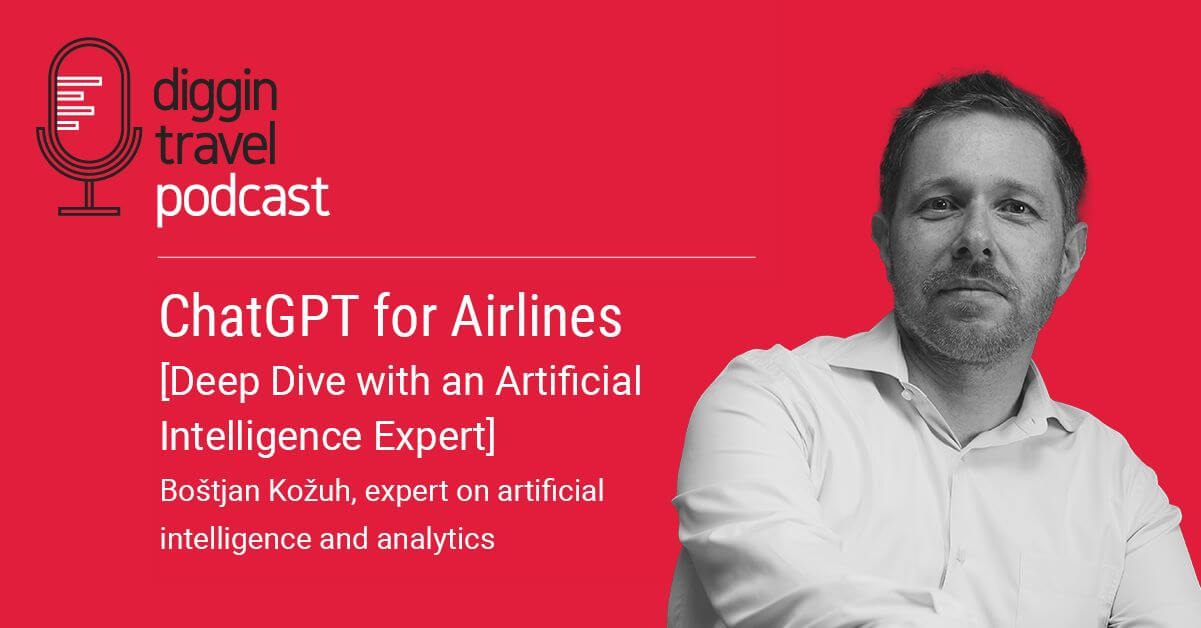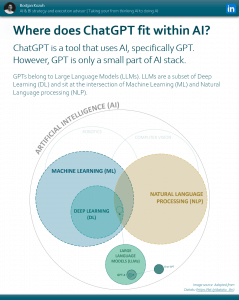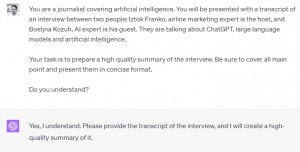Select Sidearea
Populate the sidearea with useful widgets. It’s simple to add images, categories, latest post, social media icon links, tag clouds, and more.


hello@youremail.com
+1234567890
+1234567890
Populate the sidearea with useful widgets. It’s simple to add images, categories, latest post, social media icon links, tag clouds, and more.


Iztok Franko

Writing an article about ChatGPT for airlines was long overdue. By now, everybody has heard about it and most of us have played around with it, meaning we’ve at least used the ChatGPT prompt to see how it works. But ChatGPT and the new artificial intelligence models are much more than that.
There is so much partial and unstructured information about ChatGPT that I felt there is a real need to talk about ChatGPT and its implications for airlines in a top-down, systematic way – to explain what ChatGPT really is, how it fits into the bigger scheme of artificial intelligence, and how you should use it to help you work smarter in the future.
To do that, I talked to my colleague Bostjan Kozuh, our past Airline Digital Academy data and analytics instructor, and one of the smartest people I know when it comes to artificial intelligence and data science. Bostjan has finished several data science trainings at Massachusetts Institute of Technology and Harvard University and is a mentor for many companies on AI strategy.
Think of this episode as a ChatGPT 101 for you.
NOTE: During our chat, I challenged Bostjan to use ChatGPT to write our recap article. So what you’ll read below is the first Diggintravel ChatGPT-generated article!
While I appreciate ChatGPT’s effort, I encourage everyone to listen to the full podcast episode for full context because Bostjan was great at breaking down complex concepts into easy-to-understand answers.
Listen to the new episode of the Diggintravel Podcast to learn everything you need to know about ChatGPT and its implications for airlines, or read on for key highlights from our talk with Bostjan:
And don’t forget to subscribe to the Diggintravel Podcast in your preferred podcast app to stay on top of the latest airline data science, digital optimization, and UX trends!
In a recent interview, Bostjan Kozuh and Iztok Franko explored the implications and applications of ChatGPT within the expansive landscape of generative AI. Bostjan clarified that while ChatGPT, a tool using the GPT (generative pre-trained transformer) model, has garnered popularity, it is just one component in a vast array of generative AI technologies developed by entities such as OpenAI and Google.

Source: Bostjan Kozuh (LinkedIn)
The key to fully appreciating ChatGPT, according to Bostjan, lies in understanding its context within the wider AI ecosystem. While large language models (LLMs) like GPT, which are pre-trained on extensive amounts of text data, can generate diverse content, it’s important to remember that ChatGPT is just one tool among many.
To begin using ChatGPT in various applications, airlines should educate key decision-makers on different aspects of AI. Here, the focus is to create a policy defining the intended use of the new technology, including its impact on employees and any legal or privacy aspects. The subsequent step involves forming a multidisciplinary internal AI council to help generate use cases and think about the long-term implications for their industry.
Taking all these steps should result in a comprehensive AI strategy that not only looks at GPT-based models but considers the broader AI landscape.
Recommending a strategic approach, Bostjan advised initiating AI integration with small experiments and specific use cases, gradually incorporating it into various operational areas such as training, competition analysis, and customer feedback.
The goal here is to prepare organizations for the inevitable changes that AI will bring, considering that tech giants like Google and Microsoft have already made strides in integrating AI into their products and services.
Sentiment analysis could be one area to start with (editor’s note: you can hear about a detailed airline-specific case in the podcast interview). Or the HR department could consider the onboarding process and skill requirements when hiring new employees.
Large language models in the airline industry could also be used in revenue management, understanding competition, analyzing website-user behavior, and aiding in onboard crew communication.

While generative AI, like ChatGPT, can be beneficial in areas such as understanding competitive landscapes or analyzing specific behaviors on a website, other areas, like price optimization, still require traditional AI methods. This illustrates that different AI tools have different uses, and choosing the right ones for specific tasks is crucial.
Large language models have been trained on generic textual data, which is often not enough for specific use cases or terminology. To overcome this deficiency, users might need to further “train” or tune pre-existing large language models. Bostjan clarified that such tuning is not akin to taking a readymade solution off the shelf. It is crucial to find ways to input your own organization’s context and content into the model in line with its specific needs.
In the discussion, Bostjan talked about two levels of talking to the models: prompt design and prompt engineering.
Prompt design is more straightforward and is what we usually do when we talk to ChatGPT.

ChatGPT prompt used by Bostjan Kozuh to generate summary for this article
NOTE: This is how Bostjan used the prompt for this article summary: “The procedure of preparing a summary of the podcast discussion began with setting an initial prompt for ChatGPT. It’s always beneficial to assign a specific role to ChatGPT while providing it with sufficient context, thereby orienting it towards a focused task. After the initial summary was generated by ChatGPT, I prompted it for clarifications on certain aspects; for instance, I requested, ‘Could you please make the paragraph concerning strategy clearer?’ The process ended with a few manual modifications and minor edits to enhance the overall clarity and precision of the summary.”
On the other hand, prompt engineering is a more advanced process and often involves leveraging an API to adjust various parameters based on business requirements or specific needs. Most likely, this also involves what Bostjan refers to as “embedding” or “grounding,” which entails constructing the prompt in such a way that it includes relevant data or knowledge. However, this process has limitations due to the prompt length restriction in current models.
Despite the usability of AI tools, Bostjan stresses the importance of human control and oversight. AI is still an assistant, and its outputs need to be checked for accuracy and reliability, given the legal responsibilities and ethical considerations attached to their use. Here as well, organizations must adopt a strategic approach to better harness the potential of AI while understanding and mitigating the risks involved.
If you want to learn more about ChatGPT for airlines or want to be the first to know when our next Airline Digital Talk will be published, please:
I am passionate about digital marketing and ecommerce, with more than 10 years of experience as a CMO and CIO in travel and multinational companies. I work as a strategic digital marketing and ecommerce consultant for global online travel brands. Constant learning is my main motivation, and this is why I launched Diggintravel.com, a content platform for travel digital marketers to obtain and share knowledge. If you want to learn or work with me check our Academy (learning with me) and Services (working with me) pages in the main menu of our website.
Download PDF with insights from 55 airline surveyed airlines.
Thanks! You will receive email with the PDF link shortly. If you are a Gmail user please check Promotions tab if email is not delivered to your Primary.
Seems like something went wrong. Please, try again or contact us.


No Comments